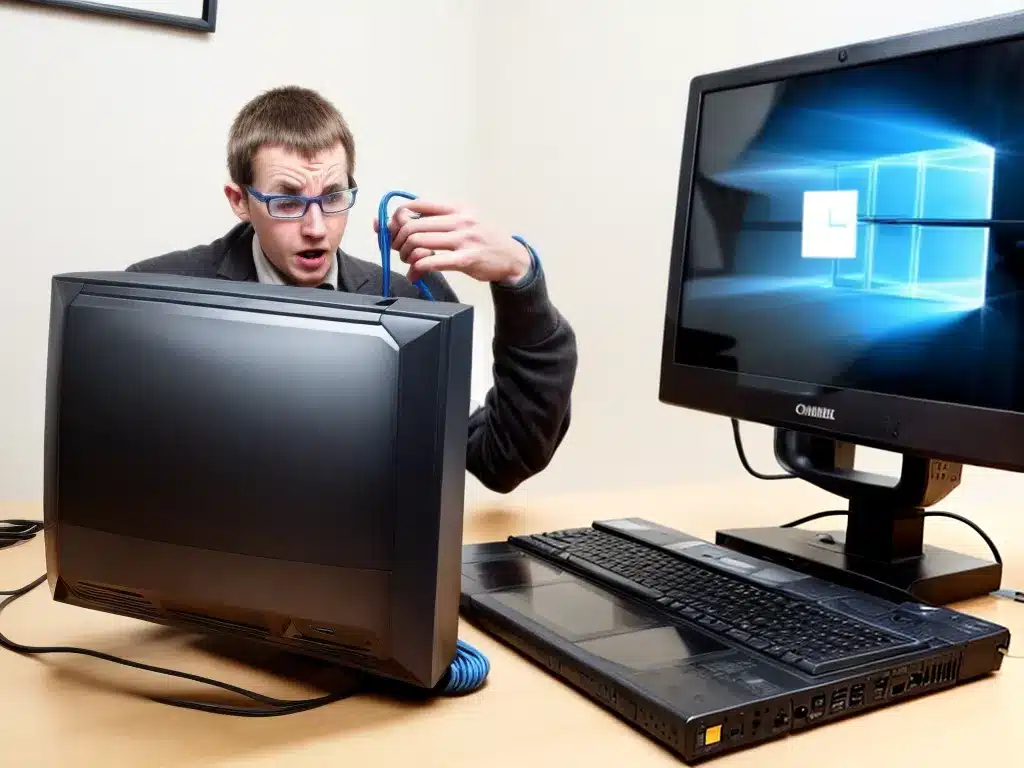
When my computer suddenly won’t turn on, it can be frustrating and worrisome. However, there are a number of troubleshooting steps I can take to try to diagnose and resolve the issue. Here is an in-depth guide on how I troubleshoot a computer that won’t power on.
1. Check the Power Cable and Outlet
The first thing I do is ensure the computer is plugged into a working power outlet. I check that:
-
The power cable is firmly plugged into the back of the computer and the wall outlet. Loose connections can prevent power from flowing.
-
I try using another power cable if possible, to rule out a faulty cable.
-
I plug another device into the same outlet to confirm it is functioning.
-
I try connecting the computer to a different outlet in case the original one is no longer supplying electricity.
-
I check the power strip is turned on and functioning, if applicable.
2. Check the Power Supply Unit
The next component I inspect is the power supply unit (PSU). I open up the computer case and examine the PSU for any visible damage, listen for fan noise, and smell for burnt smells.
-
If the PSU is making no noise and has no indicator lights, it likely has failed and needs to be replaced.
-
I can test the PSU with a multimeter or by swapping in a known-good replacement to confirm.
-
Loose PSU cables can also prevent power flow, so I re-seat all PSU connectors firmly.
3. Verify Front Panel Connections
I also open up the case to check that the front panel power button and LED connectors are properly attached to the motherboard header pins.
-
These can work loose and break the electrical switch connections needed to power on.
-
Consulting the motherboard manual, I ensure all front panel pins are aligned and snapped in completely.
4. Check Internal Components
Next, I power the computer on with the case open and watch closely to see if any internal components are powering on:
-
Motherboard lights should activate. If not, the motherboard itself or CPU may be faulty.
-
Case and CPU fans should start spinning. No fan activity indicates a further power delivery issue.
-
GPU fan should spin and GPU lights should blink if properly installed.
-
HDD activity light should flicker, showing the boot drive is being accessed.
If some components power on but others do not, it points to a specific component failure rather than a complete power issue.
5. Reset CMOS Battery
Resetting the CMOS battery can resolve power issues caused by incorrect or corrupt BIOS settings:
-
I unplug power, open the case, and remove the flat watch-style CMOS battery from the motherboard for 5 minutes before reinserting it.
-
Some motherboards also have a CMOS reset jumper I can use to achieve the same effect without removing the battery.
6. Test Components Individually
If I cannot isolate the issue through the previous steps, I start testing components individually:
-
I remove unnecessary peripherals and non-boot devices to simplify the troubleshooting.
-
I try booting with only 1 RAM stick, alternate sticks, and even try external RAM if possible.
-
I try booting with integrated graphics instead of a GPU by removing the graphics card.
-
I attempt booting with another compatible PSU, CPU, or motherboard, if available.
By minimizing components to the essentials for POST and booting, I can definitively determine which piece is responsible for the power failure.
7. Consider Sending Components for Repair
If I cannot get the computer to boot after all troubleshooting steps, I consider seeking professional repair assistance. Many companies offer services to diagnose and replace damaged components, which may be the only solution when dealing with a serious power issue.
With patience and by methodically checking each component, I can usually get to the bottom of a computer that will not turn on. But if all else fails, repair technicians can be called upon to perform diagnostics and repairs beyond DIY solutions.












